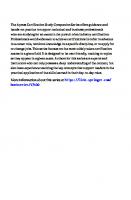Microsoft Certified Exam guide - Azure Fundamentals (AZ-900): A Comprehensive Guide to Azure Fundamentals (AZ-900) - Microsoft Certification
Microsoft Certified Exam guide - Azure Fundamentals (AZ-900) Unlock the Power of Azure with Confidence! Are you ready
208 43 997KB
English Pages 473 Year 2023
Table of contents :
1. Introduction
1.1. Understanding Microsoft Certification
1.2. The Value of Azure Fundamentals Certification
1.3. Exam Overview and Structure
1.4. Strategies for Exam Preparation
2. Introduction to Cloud Services
2.1. What is Cloud Computing?
2.2. Benefits of Cloud Computing
2.3. Service Delivery Models
2.4. Deployment Models in Cloud Computing
2.5. Public, Private, and Hybrid Clouds
2.6. Economics of Cloud Computing
2.7. Compliance and Legal Considerations
3. Core Azure Services and Products
3.1. Overview of Azure Core Services
3.2. Azure Compute Options
3.3. Azure Storage Solutions
3.4. Azure Networking Capabilities
3.5. Azure Database Services
3.6. Azure Marketplace
4. Core Azure Architectural Components
4.1. Azure Regions and Datacenters
4.2. Resource Groups and Resources
4.3. Azure Resource Manager (ARM)
4.4. Virtual Machines (VMs) and Virtual Networks
4.5. Azure App Services and Azure Functions
5. Azure Compute Services
5.1. Virtual Machines (VMs)
5.2. Azure Container Instances (ACI) and Kubernetes Service (AKS)
5.3. Windows Virtual Desktop
5.4. App Service and Functions
6. Azure Networking Services
6.1. Virtual Network and Subnets
6.2. Load Balancers and Application Gateways
6.3. VPN Gateway and ExpressRoute
6.4. Network Security Groups and Application Security Groups
6.5. Content Delivery Network (CDN) and Azure Front Door
7. Storage and Database Services
7.1. Azure Blob Storage
7.2. Azure Files and File Sync
7.3. Azure Queues and Tables
7.4. SQL Database and Azure Cosmos DB
7.5. Azure Managed Disks
7.6. Backup and Site Recovery
8. Azure Management Tools
8.1. Azure Portal and Cloud Shell
8.2. Azure PowerShell and CLI
8.3. Azure Advisor
8.4. Azure Monitor and Azure Service Health
8.5. Azure Automation and Azure Resource Manager Templates
9. Security Tools and Features
9.1. Azure Security Center
9.2. Azure Key Vault
9.3. Azure Sentinel
9.4. Azure Dedicated Hosts
10. Identity Services
10.1. Azure Active Directory
10.2. Multi-Factor Authentication
10.3. Azure AD B2C and B2B
10.4. Role-Based Access Control (RBAC)
11. Network Security and Resilience
11.1. Network Security Groups (NSGs)
11.2. Azure Firewall
11.3. DDoS Protection
11.4. Application Gateway WAF
12. Data Protection and Compliance
12.1. Data Encryption Options
12.2. Azure Policy and Blueprints
12.3. Compliance Manager
12.4. Azure Information Protection (AIP)
13. Understanding Azure Pricing
13.1. Factors Affecting Azure Pricing
13.2. Azure Pricing Calculator
13.3. Total Cost of Ownership (TCO) Calculator
14. Service Level Agreements (SLAs)
14.1. Understanding SLAs
14.2. SLAs for Core Azure Services
14.3. Composite SLAs
15. Service Lifecycles and Updates
15.1. Azure Updates
15.2. Azure Preview Features
15.3. Managing Azure Service Lifecycle
16. Case Studies and Real-World Scenarios
16.1. Implementing Solutions with Azure Services
16.2. Case Study: A Retail Company Moving to Azure
16.3. Case Study: A Health Service on Azure
16.4. Case Study: Azure for a Financial Services Firm
16.5. Case Study: Education Institution Leveraging Azure
16.6. Scenario-Based Questions and Solutions
17. Best Practices for the AZ-900 Exam
17.1. Time Management
17.2. Reading and Understanding Questions
17.3. Dealing with Difficult Questions
17.4. Review and Feedback Mechanisms
18. Appendices and Additional Resources
18.1. Exam Objectives Cross-Reference
18.2. Azure Resources and Terminology
18.3. PowerShell and CLI Reference
18.4. Additional Study Materials and Books
18.5. Free Online Resources
18.6. Changes and Updates to Azure Services
18.7. About the author
1. Introduction
1.1. Understanding Microsoft Certification
1.2. The Value of Azure Fundamentals Certification
1.3. Exam Overview and Structure
1.4. Strategies for Exam Preparation
2. Introduction to Cloud Services
2.1. What is Cloud Computing?
2.2. Benefits of Cloud Computing
2.3. Service Delivery Models
2.4. Deployment Models in Cloud Computing
2.5. Public, Private, and Hybrid Clouds
2.6. Economics of Cloud Computing
2.7. Compliance and Legal Considerations
3. Core Azure Services and Products
3.1. Overview of Azure Core Services
3.2. Azure Compute Options
3.3. Azure Storage Solutions
3.4. Azure Networking Capabilities
3.5. Azure Database Services
3.6. Azure Marketplace
4. Core Azure Architectural Components
4.1. Azure Regions and Datacenters
4.2. Resource Groups and Resources
4.3. Azure Resource Manager (ARM)
4.4. Virtual Machines (VMs) and Virtual Networks
4.5. Azure App Services and Azure Functions
5. Azure Compute Services
5.1. Virtual Machines (VMs)
5.2. Azure Container Instances (ACI) and Kubernetes Service (AKS)
5.3. Windows Virtual Desktop
5.4. App Service and Functions
6. Azure Networking Services
6.1. Virtual Network and Subnets
6.2. Load Balancers and Application Gateways
6.3. VPN Gateway and ExpressRoute
6.4. Network Security Groups and Application Security Groups
6.5. Content Delivery Network (CDN) and Azure Front Door
7. Storage and Database Services
7.1. Azure Blob Storage
7.2. Azure Files and File Sync
7.3. Azure Queues and Tables
7.4. SQL Database and Azure Cosmos DB
7.5. Azure Managed Disks
7.6. Backup and Site Recovery
8. Azure Management Tools
8.1. Azure Portal and Cloud Shell
8.2. Azure PowerShell and CLI
8.3. Azure Advisor
8.4. Azure Monitor and Azure Service Health
8.5. Azure Automation and Azure Resource Manager Templates
9. Security Tools and Features
9.1. Azure Security Center
9.2. Azure Key Vault
9.3. Azure Sentinel
9.4. Azure Dedicated Hosts
10. Identity Services
10.1. Azure Active Directory
10.2. Multi-Factor Authentication
10.3. Azure AD B2C and B2B
10.4. Role-Based Access Control (RBAC)
11. Network Security and Resilience
11.1. Network Security Groups (NSGs)
11.2. Azure Firewall
11.3. DDoS Protection
11.4. Application Gateway WAF
12. Data Protection and Compliance
12.1. Data Encryption Options
12.2. Azure Policy and Blueprints
12.3. Compliance Manager
12.4. Azure Information Protection (AIP)
13. Understanding Azure Pricing
13.1. Factors Affecting Azure Pricing
13.2. Azure Pricing Calculator
13.3. Total Cost of Ownership (TCO) Calculator
14. Service Level Agreements (SLAs)
14.1. Understanding SLAs
14.2. SLAs for Core Azure Services
14.3. Composite SLAs
15. Service Lifecycles and Updates
15.1. Azure Updates
15.2. Azure Preview Features
15.3. Managing Azure Service Lifecycle
16. Case Studies and Real-World Scenarios
16.1. Implementing Solutions with Azure Services
16.2. Case Study: A Retail Company Moving to Azure
16.3. Case Study: A Health Service on Azure
16.4. Case Study: Azure for a Financial Services Firm
16.5. Case Study: Education Institution Leveraging Azure
16.6. Scenario-Based Questions and Solutions
17. Best Practices for the AZ-900 Exam
17.1. Time Management
17.2. Reading and Understanding Questions
17.3. Dealing with Difficult Questions
17.4. Review and Feedback Mechanisms
18. Appendices and Additional Resources
18.1. Exam Objectives Cross-Reference
18.2. Azure Resources and Terminology
18.3. PowerShell and CLI Reference
18.4. Additional Study Materials and Books
18.5. Free Online Resources
18.6. Changes and Updates to Azure Services
18.7. About the author

- Similar Topics
- Computers
- System Administration




![Microsoft Certified Azure Fundamentals Study Guide: Exam AZ-900 [1 ed.]
9781119770923, 9781119768203, 9781119771159, 1119770920](https://ebin.pub/img/200x200/microsoft-certified-azure-fundamentals-study-guide-exam-az-900-1nbsped-9781119770923-9781119768203-9781119771159-1119770920.jpg)



